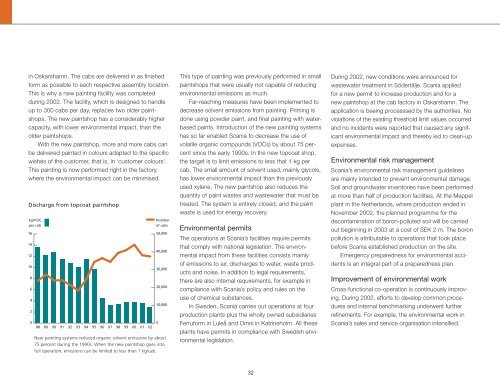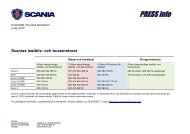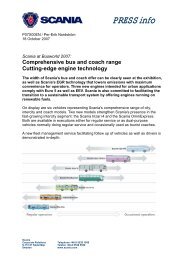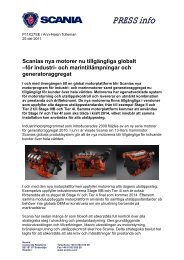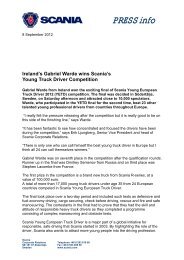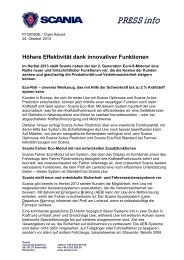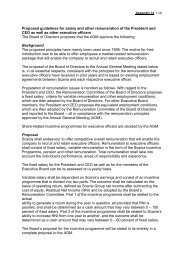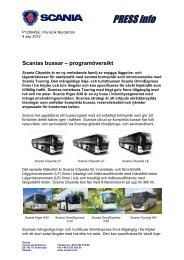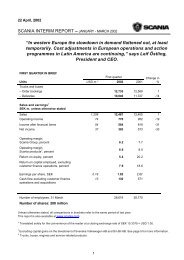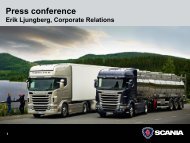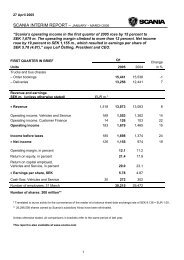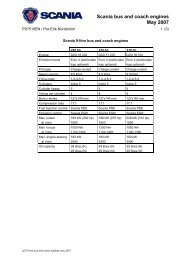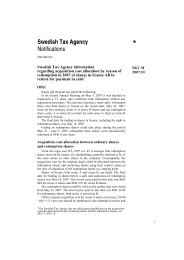Scania annual report 2002
Scania annual report 2002
Scania annual report 2002
You also want an ePaper? Increase the reach of your titles
YUMPU automatically turns print PDFs into web optimized ePapers that Google loves.
in Oskarshamn. The cabs are delivered in as finished<br />
form as possible to each respective assembly location.<br />
This is why a new painting facility was completed<br />
during <strong>2002</strong>. The facility, which is designed to handle<br />
up to 300 cabs per day, replaces two older paintshops.<br />
The new paintshop has a considerably higher<br />
capacity, with lower environmental impact, than the<br />
older paintshops.<br />
With the new paintshop, more and more cabs can<br />
be delivered painted in colours adapted to the specific<br />
wishes of the customer, that is, in ‘customer colours’.<br />
This painting is now performed right in the factory,<br />
where the environmental impact can be minimised.<br />
Discharge from topcoat paintshop<br />
kg/VOC<br />
per cab<br />
16<br />
14<br />
12<br />
10<br />
8<br />
6<br />
4<br />
2<br />
0<br />
88<br />
89<br />
90<br />
91<br />
92<br />
93<br />
94<br />
95<br />
96<br />
97<br />
98<br />
99<br />
00<br />
01<br />
02<br />
Number<br />
of cabs<br />
50,000<br />
40,000<br />
30,000<br />
20,000<br />
10,000<br />
New painting systems reduced organic solvent emissions by about<br />
75 percent during the 1990s. When the new paintshop goes into<br />
full operation, emissions can be limited to less than 1 kg/cab.<br />
0<br />
This type of painting was previously performed in small<br />
paintshops that were usually not capable of reducing<br />
environmental emissions as much.<br />
Far-reaching measures have been implemented to<br />
decrease solvent emissions from painting. Priming is<br />
done using powder paint, and final painting with waterbased<br />
paints. Introduction of the new painting systems<br />
has so far enabled <strong>Scania</strong> to decrease the use of<br />
volatile organic compounds (VOCs) by about 75 percent<br />
since the early 1990s. In the new topcoat shop,<br />
the target is to limit emissions to less that 1 kg per<br />
cab. The small amount of solvent used, mainly glycols,<br />
has lower environmental impact than the previously<br />
used xylene. The new paintshop also reduces the<br />
quantity of paint wastes and wastewater that must be<br />
treated. The system is entirely closed, and the paint<br />
waste is used for energy recovery.<br />
Environmental permits<br />
The operations at <strong>Scania</strong>’s facilities require permits<br />
that comply with national legislation. The environmental<br />
impact from these facilities consists mainly<br />
of emissions to air, discharges to water, waste products<br />
and noise. In addition to legal requirements,<br />
there are also internal requirements, for example in<br />
compliance with <strong>Scania</strong>’s policy and rules on the<br />
use of chemical substances.<br />
In Sweden, <strong>Scania</strong> carries out operations at four<br />
production plants plus the wholly owned subsidiaries<br />
Ferruform in Luleå and Omni in Katrineholm. All these<br />
plants have permits in compliance with Swedish environmental<br />
legislation.<br />
During <strong>2002</strong>, new conditions were announced for<br />
wastewater treatment in Södertälje. <strong>Scania</strong> applied<br />
for a new permit to increase production and for a<br />
new paintshop at the cab factory in Oskarshamn. The<br />
application is beeing processsed by the authorities. No<br />
violations of the existing threshold limit values occurred<br />
and no incidents were <strong>report</strong>ed that caused any significant<br />
environmental impact and thereby led to clean-up<br />
expenses.<br />
Environmental risk management<br />
<strong>Scania</strong>’s environmental risk management guidelines<br />
are mainly intended to prevent environmental damage.<br />
Soil and groundwater inventories have been performed<br />
at more than half of production facilities. At the Meppel<br />
plant in the Netherlands, where production ended in<br />
November <strong>2002</strong>, the planned programme for the<br />
decontamination of boron-polluted soil will be carried<br />
out beginning in 2003 at a cost of SEK 2 m. The boron<br />
pollution is attributable to operations that took place<br />
before <strong>Scania</strong> established production on the site.<br />
Emergency preparedness for environmental accidents<br />
is an integral part of a preparedness plan.<br />
Improvement of environmental work<br />
Cross-functional co-operation is continuously improving.<br />
During <strong>2002</strong>, efforts to develop common procedures<br />
and internal benchmarking underwent further<br />
refinements. For example, the environmental work in<br />
<strong>Scania</strong>’s sales and service organisation intensified.<br />
32


